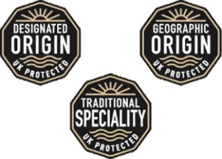Trade Mark Director Adjoa Anim highlights the changes to the UK Geographical Indication system.
There was a lot of excitement over Gower Salt Marsh Lamb becoming the first UK Geographical Indication (GI) to be award protected designation of origin (PDO) status. The PDO for this South Welsh prime lamb joins other GIs that were registered under the pre-existing EU system. After the UK left the EU, a new system has been set up to protect these rights.
What is a GI?
A GI is a sign used on products that have a specific geographical origin and possess qualities or a reputation that are due to that origin. They are used to protect food, drink and agricultural products, including, Parma ham, London Cure Smoked Salmon, Scotch whiskey and Gouda cheese.
Apart from Gower Salt Marsh lamb, there are pending applications for Dundee cake, New Forest Pannage ham and Watercress. Use of GIs give products prestige as they act as guarantors of authenticity, process and origin. Unlike trade marks, GIs are not owned by individual or businesses. Any producer can sell products under a protected GI by meeting the criteria below:
- Follow the specifications of the product;
- Be verified to produce and sell the product; and,
- Use the registered GI name and relevant logo correctly.
How has the registration system changed?
Until 31 December 2020, EU law provided protection for GIs in the UK under four forms; Protected Designation of Origin (PDO), Protected Geographical Indication (PGI), specific GIs for spirit drinks and aromatised wines and Traditional Speciality Guaranteed (TSG), using the following logos:

The UK Government set up its own scheme, effective from 1 January 2021. The Department for Environment, Food and Rural Affairs (Defra) manages the scheme, maintains the registers of product names and processes new applications for the three types of UK GIs, using the following logos:

The logos will be used for the UK's four GI schemes, covering the following types of products:
- Food, agricultural products, beer, cider and Perry
- Wine
- Aromatised wine
- Spirit drinks
Some finer points
The UK system protects new GIs in Great Britain and will be open to producers inside and outside the country. Great Britain producers should secure protection under the UK scheme before applying to the EU scheme, and EU producers have to do vice versa.
For the duration of the Northern Ireland Protocol, special rules apply in relation to Northern Ireland. To protect a new GI in Northern Ireland, producers will have to use the EU scheme. Northern Irish producers will have a parallel system for products protected under the EU and UK GIs; additionally, they can seek protection in the UK, without obtaining protection in the EU. Registered GIs for products produced in the Republic of Ireland and /or Northern Ireland, including Irish Whiskey, will continue to be protected in the UK and EU. Defra also maintains the Northern Irish schemes.
All GIs protected in the EU before 1 January 2021, are protected in the UK and EU, under the respective GI schemes. GIs for products protected under EU system are 'cloned' and protected under the UK system. Producers that used [EU] GIs in the UK before 31 December 2020 have three years to update packaging and marketing materials with the new UK logos. Producers that register GIs under the new UK system from 1 January 2021 must use the new logos, as soon as they have registered protection.
Why take note
During the transition period, producers and retailers will need to incorporate the new UK GI logos on all packaging and marketing materials. There is also updated guidance available from Defra to be reviewed and actioned as required.
Looking to the future
Defra will continue to manage both Great Britain and Northern Irish schemes. It will be interesting to see how the they are merged once the Norther Ireland Protocol has ended.
The content of this article is intended to provide a general guide to the subject matter. Specialist advice should be sought about your specific circumstances.

